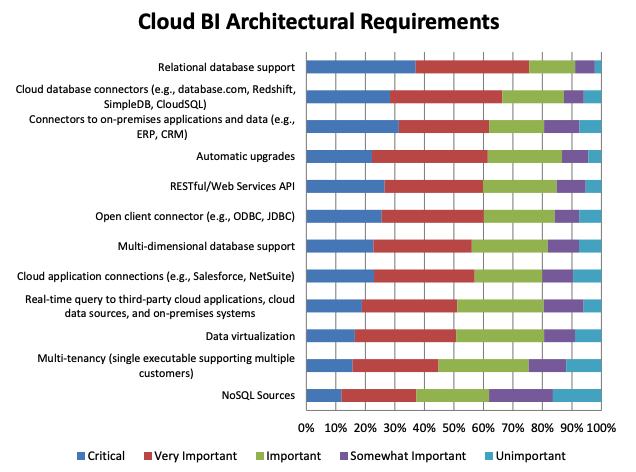Skip Navigation
Today, businesses have access to massive amounts of data they can use to derive business intelligence (BI) for faster, better decision-making. The variety and complexity of this data drive the need for efficient, cost-effective ways to create data analytics. Increasingly, cloud data warehouses and cloud BI tools provide the solution.
According to Dresner Advisory Services' 2019 Cloud Computing and Business Intelligence Market Study, 48% of organizations indicate cloud business intelligence is either “critical” or “very important,” and current use of and future plans for deploying cloud BI continue to grow.
So, what’s driving the growth of cloud BI?
Find the fastest path to business intelligence
Cloud business intelligence applications
Businesses have so much data from so many sources that it's impossible to make informed business decisions without BI tools that take all of that big data into account.
Business managers and data analysts use BI tools to mine data to learn what has happened and what is currently happening in the business, and to suggest actions they should take.
A cloud BI platforms takes information derived from the data and presents it in a visual format. BI users need advanced visualization tools, ad-hoc query capabilities, and personalized dashboards. People across an organization want to be able to ask questions about any part of their data set, and they want a personalized, visual representation of the answers.

Source: Dresner Advisory Services
Cloud data warehouses
Data warehouses are the foundation for business intelligence. They replicate data from multiple sources into a repository that can serve as a single source of truth for an organization's analytics. The repository is structured and optimized for analytics processing.
A few years ago, data warehouses were on-premises systems with a fixed capacity for processing and storage, which meant they were unable to scale easily or quickly in times of high demand. Today, cloud data warehouses replace some legacy on-premises systems, and they are a popular choice for many organizations adopting new systems.
Cloud data warehouses, such as Snowflake, Amazon Redshift, Microsoft Azure SQL Data Warehouse, and Google BigQuery, have numerous advantages over on-premises systems:
Speed and scalability
Cloud data warehouses offer speed and scalability that legacy systems cannot. The cloud platform provides the ability to quickly scale to meet just about any processing demands. Administrators can scale processing and storage resources up or down with a few mouse clicks.
Cost savings
The cloud offers infrastructure on a cost-effective subscription-based pay-as-you-go model. Software and security updates are automatic and included in the subscription.
Security
Cloud data warehouses have data security covered with always-on, end-to-end data encryption and built-in protection against loss of data (accidental or malicious), and they adapt to new security threats by deploying countermeasures quickly. Cloud data warehouses also address a variety of compliance standards, such as SOC 1 and SOC 2, PCI DSS Level 1, and HIPAA.
Availability
Many cloud data warehouses are built for high availability, spanning many availability zones or data centers. If a data center goes out, work shifts to another available data center, and the disruption goes unnoticed by the user.
Put it together with ETL
Data engineers, database administrators, and other data professionals help to identify data sources and design their organization's data warehouse. They then populate it with data using ETL tools to extract, transform, and load data from the data sources.
Businesses can simplify and streamline data ingestion by using a cloud-based ETL tool that regularly replicates source data to the data warehouse. Instead of having a data professional who must write the ETL code and manage the infrastructure around it (such as alerting and reporting), an ETL tool automates the process of connecting to and extracting data from sources and loading the data into the destination.
Stitch makes it easy for anyone in an organization to work with data sources and destinations. Once your data is in your data warehouse, you can analyze it with any business intelligence tool, such as Microsoft Power BI, Google Data Studio, Tableau, or Metabase.
The Stitch solution is simple, straightforward, and ready to go right out of the box. No need to wait — set up a free trial in minutes and make more of your data sources available for BI more quickly.
Give Stitch a try, on us
Stitch streams all of your data directly to your analytics warehouse.
Set up in minutesUnlimited data volume during trial